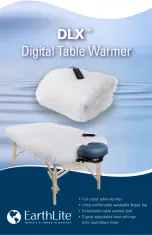
Care and Maintenance
To enjoy years of outstanding performance from your heater, make sure you perform the following
maintenance activities on a regular basis:
Keep exterior surface clean.
Use warm soapy water for cleaning. Never use flammable or corrosive cleaning agents.
While cleaning your unit, be sure to keep the area around the burner and pilot assembly dry at all
times. Do not submerge the control valve assembly. If the gas control is submerged in water, DO
NOT use it. It must be replaceed.
Air flow must be unobstructed. Keep controls, burner, and circulating air passageways clean. Signs
of possible blockage include:
•
Gas odor with extreme yellow tipping of flame.
•
Heater does NOT reach the desired temperature.
•
Heater glow is excessively uneven.
•
Heater makes popping noise.
•
Spider and insects can nest in the burners of this or
any other heater and cause the gas to flow from the front of the burner. This is a very dangerous
condition which can cause a fire to occur behind the valve panel, thereby damaging the heater and
making it unsafe to operate. We recommend you check the heater and remove any spiders, insects
and webs at least once a year to reduce this risk.
• Carbon deposits may create a fire hazard. Clean reflector and burner screen with warm soapy
water if any carbon deposits develop.
Note: In a salt-air environment (such as near an ocean) corrosion occurs more quickly than normal.
Frequently check for corroded areas and repair them promptly.
20
▲
!
WARNING
FOR YOUR SAFETY
DO NOT touch or move heater for at
least 45 minutes after use.
Reflector is hot to the touch.
Allow reflector to cool before touching.
TIP:
Use high quality automobile wax to help maintain the appearance of your heater. Apply to exterior
surface from the pole down. Do not apply to emitter screen or domes.
STORAGE:
•
Turn Control Knob OFF
• Disconnect LP source
• Store heater upright in an area sheltered from direct contact with inclement weather (Such as rain,
sleet, hail snow, dust and debris).
• If desired, cover heater to protect exterior surfaces and to help prevent build up in air passages.
NOTE:
Wait until heater is cool before covering.



































